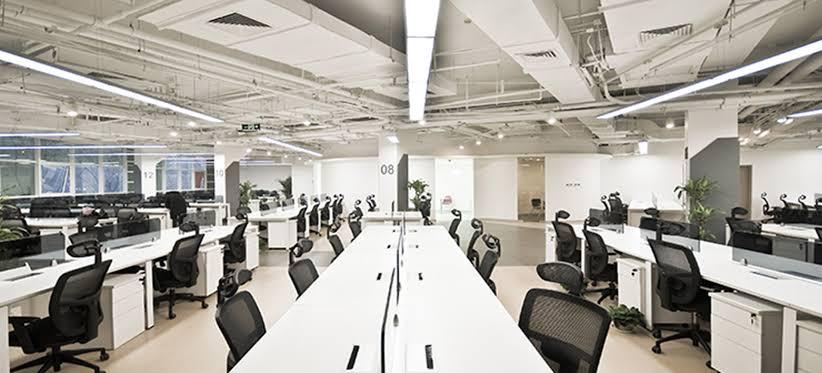India’s office market net absorption** at a three-year high of 38.25 million sq. ft in 2022: JLL
- This makes it higher than the pre-pandemic 5-year average
- Bengaluru leads with a 23.7% share of net absorption for 2022
- Delhi NCR, Hyderabad and Chennai show strong year-end momentum to power ahead of Mumbai and Bengaluru in Q4 net absorption
India’s office market net absorption across the top seven cities (Mumbai, Delhi NCR, Bengaluru, Hyderabad, Chennai, Kolkata, and Pune) for the full year was recorded at 38.25 million sq. ft, hitting a three-year high. The net absorption for the calendar year 2022 has surpassed the five-year pre-pandemic average (2015-2019) by 3.1% as well and is second only to the 2019 net absorption numbers for the past 10 years, showcasing the strong resilience of the Indian office markets.
On a Quarter-on-Quarter (Q-O-Q) basis, net absorption is down by 19.0% at 7.99 million sq. ft, as early signs of sluggishness driven by global headwinds saw delayed decision-making and a cautious approach from occupiers impacting deal closures in the last quarter of the year. In Q4 2022, Delhi NCR led the way with a 23.7% share of net absorption, with Hyderabad and Chennai showing strong year-end momentum to power ahead of even Mumbai and Bengaluru during the quarter. The top three cities, combined for a 60.9% share of net absorption in Q4 2022, driven by strong supply addition backed with previous pre-commitments.
“The office market in India has made a strong recovery in 2022 with the year emerging as the strongest in terms of office market performance post-COVID and second only to 2019 over the last decade. Even with the evolving hybrid work ecosystem, we have seen a sharp rise in office occupancy levels. This has resulted in a strong demand pick-up with occupiers approaching their real estate strategies with greater clarity and agility. Bengaluru retained its leadership position accounting for the highest net absorption for the calendar year 2022, with Hyderabad close behind in the second spot. The full-year net absorption for all cities is higher than the 2021 numbers. Pan-India net absorption as a result was a strong 46.1% higher on a Y-o-Y basis,” said Rahul Arora, Head Office Leasing Advisory India & MD, Karnataka & Kerala at JLL India. India’s momentum as an actively growing office market with new job creation, its established and further-growing credentials as a tech and innovation hub, companies’ expansion plans remaining intact, and more firms looking at India from a talent perspective are all strong growth drivers for the office market to have put in such a performance for 2022’ he further added.
A strong year with record-high completions and previous pre-commitments being honored by most occupiers as return to work has gained momentum across all industries pushing office occupancies higher, has supported the net absorption numbers for 2022.
“Over the next 12 months, around 53-58 million sq. ft is lined up with average pre-commitment levels of 14-17%. For assets owned by institutional landlords which are 30% of the supply pipeline, pre-commitment rates stand at 22-25%, signaling the flight to quality with healthy workspaces and ESG considerations being given significant weightage during space planning. Space requirements have shown a slight softening with active requirements declining by about 15% as many real estate plans have gone on hold or put off indefinitely given the evolving macroeconomic headwinds. We are likely to see some delayed decision-making as businesses look at macroeconomic signals before committing capital for new offices. Driven by segments like flex, healthcare-life sciences, GCCs and manufacturing/industrial along with its leadership position in the global tech ecosystem, office demand is expected to be similar to 2022 with a marginal to slight upside,” said Dr. Samantak Das, Chief Economist and Head of Research and REIS, India, JLL.
| Net Absorption (Mn sq ft) | Q4 2021 | Q3 2022 | Q4 2022 | Q-O-Q Growth (%) | Y-O-Y Growth (%) |
| Bengaluru | 2.41 | 1.71 | 1.20 | -29.7% | -50.0% |
| Chennai | 0.85 | 0.54 | 1.24 | 129.3% | 45.4% |
| Delhi NCR | 1.61 | 1.61 | 1.89 | 17.1% | 17.1% |
| Hyderabad | 2.99 | 3.06 | 1.74 | -43.1% | -41.9% |
| Kolkata | 0.47 | 0.10 | 0.20 | 95.5% | -57.0% |
| Mumbai | 1.88 | 1.83 | 1.05 | -42.6% | -44.1% |
| Pune | 1.34 | 1.01 | 0.66 | -33.9% | -50.2% |
| Pan India | 11.55 | 9.86 | 7.99 | -19.0% | -30.8% |
| Net Absorption (mn sq ft) | 2021 | 2022 | Y-O-Y Growth (%) |
| Bengaluru | 7.82 | 9.05 | 15.8% |
| Chennai | 2.03 | 3.51 | 72.7% |
| Delhi NCR | 4.72 | 6.16 | 30.6% |
| Hyderabad | 4.14 | 8.96 | 116.3% |
| Kolkata | 0.57 | 0.68 | 18.3% |
| Mumbai | 3.70 | 5.65 | 52.5% |
| Pune | 3.18 | 4.24 | 33.1% |
| Pan India | 26.17 | 38.25 | 46.1% |
Gross leasing up 47.4% Y-o-Y hits a three-year high; tech and flex dominate
Gross leasing activity* for the calendar year 2022 at 49.41 million sq. ft hit three-year highs as a COVID-free year and greater clarity in the business environment supported on-ground real estate activity with occupiers approaching their portfolio strategies with much more clarity. In fact, gross leasing activity for 2022 was 84% of the 2019 highs, signaling a robust post-COVID revival in market activity during the year.
Mumbai, Bengaluru and Delhi NCR accounted for a 23.5%, 19.6%, and 18.8% share of gross leasing activity during the Q4 2022 quarter.
Delhi NCR and Bengaluru are the two biggest office markets in terms of full-year 2022 gross leasing activity followed by Mumbai. These three markets account for over two-thirds share of occupier activity for the 2022 calendar year. Early-year market momentum slightly tapered off at the end of the year, slipping on the global headwinds’ slope as occupiers slowed down decision-making and waited for headline trends to emerge from their corporate HQs and global clients on overall business direction before moving ahead with their real estate strategies.
Transaction activity by tech turned slightly sluggish and was visible in its reduced market share. Tech retained its top spot but saw its share slipping for the third quarter in a row to 25.3%, while flex continued to see its golden run continue and recorded a 18.8% share of gross leasing activity. BFSI showed good momentum backed by some large transactions witnessed in Mumbai during the quarter with its share of gross leasing at 14.0%.
For the calendar year 2022, tech leads with a 27.6% share followed by flex with 18.5% and manufacturing/industrial with 13.9% shares, respectively.
Flex (ing), the enterprise way
Flex seat leasing by enterprises in the form of managed or enterprise solutions recorded its strongest quarter yet with ~38,140 seats taken up in Q4 2022. Demand for flex continues to remain on an upward curve with the flex operators’ footprint growth an apt marker of the rising role that flex is playing in real estate portfolio strategies. The calendar year 2022 flex seat take-up is hit an all-time high of 131,700+ seats, easily crossing the pre-pandemic peak of 2019 by more than 2X. The annual flex seat take-up in 2022 alone has surpassed the combined total of the pre-COVID years of 2018 and 2019 as well as the past two years 2020 and 2021.
Robust supply hits a new high
Quarterly supply at 14.83 million sq ft; up by 23.8% Q-o-Q. For the full year 2022, new completions reached a new historic high for the Indian office markets at 58.27 million sq. ft. Completions in Q4 2022 were headlined by Hyderabad and Bengaluru which combined for a 60.5% share of the quarterly supply additions. Just around 23% of the new supply infusion was pre-committed, highlighting that occupier decision-making turned slightly bearish in the last 3-4 months. A significant part of this came from new completions in Chennai, where 55% of the supply was pre-committed and Mumbai with a 28% pre-commitment rate. and Hyderabad and Bengaluru saw similar pre-commitment rates of 21% each, respectively while Delhi-NCR just had 13% pre-commitment levels.
| New Completions (mn sq ft) | Q3 2022 | Q4 2022 | Q-O-Q Growth (%) | 2021 | 2022 | Y-O-Y Growth (%) |
| Bengaluru | 1.62 | 3.55 | 119.1% | 15.24 | 14.18 | -6.9% |
| Chennai | 1.06 | 1.66 | 56.1% | 0.96 | 5.12 | 432.4% |
| Delhi NCR | 3.55 | 1.84 | -48.1% | 8.51 | 8.31 | -2.4% |
| Hyderabad | 3.66 | 5.42 | 48.3% | 9.31 | 18.46 | 98.4% |
| Kolkata | 0.00 | 0.00 | NA | 0.10 | 0.27 | 170.6% |
| Mumbai | 1.70 | 1.47 | -13.8% | 7.98 | 5.85 | -26.7% |
| Pune | 0.38 | 0.88 | 132.6% | 3.58 | 6.08 | 69.8% |
| Pan India | 11.97 | 14.83 | 23.8% | 45.67 | 58.27 | 27.6% |
Vacancy up
The Pan-India vacancy has risen to 16.6%, up 60 bps q-o-q with a stronger supply infusion compared to expansion-driven occupier activity. Vacancy going forward as well is expected to remain sticky within this range of 16-17%. The future supply pipeline is strong, and while leasing momentum is slightly lagging, moderate to strong pre-commitments in the upcoming projects and expectations of leasing activity to pick up steam by H2 2023 will support the net absorption projection and keep vacancy within range.
Looking Ahead
Given the growing outsourcing/offshoring story, India is expected to see robustness in its office markets. We will keep a close watch on global headwinds which are showing some impact in terms of stifling demand in the short-term and causing lengthened decision-making from occupiers who are looking at direction from their corporate HQs and evolving macroeconomic situation in their home countries. For domestic outsourcing firms, negotiation in new contracts could impact bottom line and headcount growth thus keeping expansion activity limited. With the Return to Work gaining full force, real estate planning will center around talent mobility, healthy workplaces and employee value proposition.
Also Read: Monthly office leasing activity for November drops by 13% month-on-month at 5.8 million sq ft









